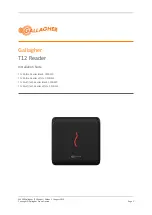
REA
VERIFIER
© REA Elektronik GmbH, 64367 Mühltal, Germany --- REA MLV-2D Manual Version 3 – 21/12/2015
Page 23 of 98
Each of the optics modules has been given a code. In this way, the software can
automatically identify which optics module is being used.
CAUTION: The optics module's lens has been optically measured and
calibrated at the factory. The alignment must not be altered and the lens
must not be reconfigured for another electronics subsystem.
4.9
Replacing the base plates
For verification work on smaller-sized cardboard
packaging – such as pharmaceutical product packs – it
can be useful to work with a base plate that has a
correspondingly smaller-scale measurement field cut-
out. This ensures that the packaging is held more
securely on the base plate and the packaging is
prevented from accidentally falling through the cut-out
in the measurement space.
When verifying larger barcodes, it is advisable to use a camera module with an
especially short focal length and a base plate with a correspondingly larger-scale
measurement field cut-out. To make the necessary adjustments, REA offers a series
of base plates with a range of measurement field cut-outs as optional accessories.
The base plates can be simply be replaced by the
operator. The base plates are secured to the 4 device
legs with 4 T1 Torx screws, which are removed in order
to replace the base plate. The base plate gives basic
stability to both the device and the legs. To ensure the
device does not become warped during fitting, the four
base plate screws must be carefully tightened in
opposing pairs (in a way similar to that used for securing
a wheel rim to a vehicle). If the screws are simply fully
tightened one after the other, then the parallel position
of the four feet may warp at the device, causing the
device to wobble when placed on a flat table.
To remove and fit a different base plate, the device needs to be turned upside down.
The blue rubber spacer rings on the terminal casing ensure the device stays safely in
place without slipping, thus preventing the keyboard or display from becoming
damaged.
During replacement work, no parts or dirt must be allowed to fall into the optical
chamber or onto the lens. The base plate must be fitted the right way around. The
angled feet are always located at the front of the device (camera module side), so the
verifier can also be set up so that it is tipped back at a 90° angle.
If a base plate is used that has a cut-out smaller than the camera's field of view,
readjustment and recalibration work is required (see section 11).
















































